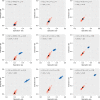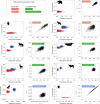Closing the gap between palaeontological and neontological speciation and extinction rate estimates
- PMID: 30532040
- PMCID: PMC6286320
- DOI: 10.1038/s41467-018-07622-y
Closing the gap between palaeontological and neontological speciation and extinction rate estimates
Abstract
Measuring the pace at which speciation and extinction occur is fundamental to understanding the origin and evolution of biodiversity. Both the fossil record and molecular phylogenies of living species can provide independent estimates of speciation and extinction rates, but often produce strikingly divergent results. Despite its implications, the theoretical reasons for this discrepancy remain unknown. Here, we reveal a conceptual and methodological basis able to reconcile palaeontological and molecular evidence: discrepancies are driven by different implicit assumptions about the processes of speciation and species evolution in palaeontological and neontological analyses. We present the "birth-death chronospecies" model that clarifies the definition of speciation and extinction processes allowing for a coherent joint analysis of fossil and phylogenetic data. Using simulations and empirical analyses we demonstrate not only that this model explains much of the apparent incongruence between fossils and phylogenies, but that differences in rate estimates are actually informative about the prevalence of different speciation modes.
Conflict of interest statement
The authors declare no competing interests.
Figures





Similar articles
-
Heritability of extinction rates links diversification patterns in molecular phylogenies and fossils.Syst Biol. 2009 Dec;58(6):629-40. doi: 10.1093/sysbio/syp069. Epub 2009 Oct 5. Syst Biol. 2009. PMID: 20525614
-
Combining palaeontological and neontological data shows a delayed diversification burst of carcharhiniform sharks likely mediated by environmental change.Sci Rep. 2022 Dec 19;12(1):21906. doi: 10.1038/s41598-022-26010-7. Sci Rep. 2022. PMID: 36535995 Free PMC article.
-
Primate diversification inferred from phylogenies and fossils.Evolution. 2017 Dec;71(12):2845-2857. doi: 10.1111/evo.13366. Epub 2017 Oct 20. Evolution. 2017. PMID: 28913907
-
Why are there so many insect species? Perspectives from fossils and phylogenies.Biol Rev Camb Philos Soc. 2007 Aug;82(3):425-54. doi: 10.1111/j.1469-185X.2007.00018.x. Biol Rev Camb Philos Soc. 2007. PMID: 17624962 Review.
-
Evolution and the latitudinal diversity gradient: speciation, extinction and biogeography.Ecol Lett. 2007 Apr;10(4):315-31. doi: 10.1111/j.1461-0248.2007.01020.x. Ecol Lett. 2007. PMID: 17355570 Review.
Cited by
-
Toward a Semi-Supervised Learning Approach to Phylogenetic Estimation.Syst Biol. 2024 Oct 30;73(5):789-806. doi: 10.1093/sysbio/syae029. Syst Biol. 2024. PMID: 38916476 Free PMC article.
-
Using the Fossil Record to Evaluate Timetree Timescales.Front Genet. 2019 Nov 12;10:1049. doi: 10.3389/fgene.2019.01049. eCollection 2019. Front Genet. 2019. PMID: 31803226 Free PMC article. Review.
-
Practical guidelines for Bayesian phylogenetic inference using Markov chain Monte Carlo (MCMC).Open Res Eur. 2024 Aug 5;3:204. doi: 10.12688/openreseurope.16679.3. eCollection 2023. Open Res Eur. 2024. PMID: 38481771 Free PMC article.
-
Calibrating phylogenies assuming bifurcation or budding alters inferred macroevolutionary dynamics in a densely sampled phylogeny of bivalve families.Proc Biol Sci. 2021 Dec 8;288(1964):20212178. doi: 10.1098/rspb.2021.2178. Epub 2021 Dec 1. Proc Biol Sci. 2021. PMID: 34847770 Free PMC article.
-
Ignoring stratigraphic age uncertainty leads to erroneous estimates of species divergence times under the fossilized birth-death process.Proc Biol Sci. 2019 May 15;286(1902):20190685. doi: 10.1098/rspb.2019.0685. Proc Biol Sci. 2019. PMID: 31064306 Free PMC article.
References
-
- Raup DM. Taxonomic survivorship curves and Van Valen’s law. Paleobiology. 1975;1:82–96. doi: 10.1017/S0094837300002220. - DOI
-
- Sepkoski JJ. A kinetic-model of phanerozoic taxonomic diversity; i. analysis of marine orders. Paleobiology. 1978;4:223–251. doi: 10.1017/S0094837300005972. - DOI
-
- Niklas KJ, Tiffney BH, Knoll AH. Patterns in vascular land plant diversification. Nature. 1983;303:614–616. doi: 10.1038/303614a0. - DOI
-
- Nee S. Birth−death models in macroevolution. Annu. Rev. Ecol. Evol. Syst. 2006;37:1–17. doi: 10.1146/annurev.ecolsys.37.091305.110035. - DOI
Publication types
MeSH terms
LinkOut - more resources
Full Text Sources
Miscellaneous

